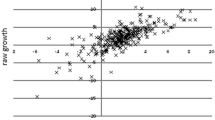Abstract
The literature on the rational PBC suggests that politicians systematically manipulate economic and fiscal conditions before elections to increase their chances of reelection. Most tests of this theory look for evidence of pre-election distortions in fiscal policy. We propose a new test that explores the two-way interaction between the magnitude of the opportunistic distortion and the margin of victory. The test is implemented using a large panel of Portuguese municipalities. The results show that opportunism leads to a larger win-margin for the incumbent and that incumbents behave more opportunistically when their win-margin is small. These results are consistent with the theoretical model.
Similar content being viewed by others
References
Akhmedov, A., & Zhuravskaya, E. (2004). Opportunistic political cycles: test in a young democracy setting. Quarterly Journal of Economics, 119, 1301–1338.
Alesina, A. (1987). Macroeconomic policy in a two-party system as a repeated game. Quarterly Journal of Economics, 102, 651–678.
Alesina, A., Londregan, J., & Rosenthal, H. (1993). A model of the political economy of the United States. American Political Science Review, 87(1), 12–33.
Alt, J., & Lassen, D. (2006). Transparency, political polarization, and political budget cycles in OECD countries. American Journal of Political Science, 50(3), 530–550.
Besley, T., & Case, A. (2003). Political institutions and policy choices: evidence from the United States. Journal of Economic Literature, XLI(1), 7–73.
Blais, A., & Nadeau, R. (1992). The electoral budget cycle. Public Choice, 74, 389–403.
Brender, A., & Drazen, A. (2005). Political budget cycles in new versus established democracies. Journal of Monetary Economics, 52(7), 1271–1295.
Brender, A., & Drazen, A. (2008). How do budget deficits and economic growth affect reelection prospects? Evidence from a large panel of countries. American Economic Review, 98(5), 2203–2220.
Carsey, T., & Wright, G. (1998). State and national factors in gubernatorial and senatorial elections. American Journal of Political Science, 42(3), 994–1002.
Carson, J., Engstrom, E., & Roberts, J. (2007). Candidate quality, the personal vote, and the incumbency advantage in Congress. American Political Science Review, 101(2), 289–301.
Cho, I.-K., & Kreps, D. (1987). Signaling games and stable equilibria. Quarterly Journal of Economics, 102, 179–221.
DGAL (1979–1983 and 1986–2001). Finanças Municipais. Direcção Geral das Autarquias Locais (DGAL), Lisbon.
Drazen, A., & Eslava, M. (2010). Electoral manipulation via expenditure composition: theory and evidence. Journal of Development Economics, 92, 39–52.
Frey, B., & Schneider, F. (1978a). An empirical study of politico-economic interaction in the United States. Review of Economics and Statistics, 60, 174–183.
Frey, B., & Schneider, F. (1978b). A politico-economic model of the United Kingdom. Economic Journal, 88, 243–253.
Galli, E., & Rossi, S. (2002). Political budget cycles: the case of the Western German Länder. Public Choice, 110, 283–303.
Goodhart, C. A. E., & Bhansali, R. J. (1970). Political economy. Political Studies, 18, 43–106.
Grier, K. (2008). US presidential elections and real GDP growth, 1961–2004. Public Choice, 135, 337–352.
Hibbs, D. (1977). Political parties and macroeconomic policy. The American Political Science Review, 7, 1467–1487.
Hibbs, D. (1987). The political economy of industrial democracies. Cambridge: Harvard University Press.
Hibbs, D. (1992). Partisan theory after fifteen years. European Journal of Political Economy, 8, 361–373.
Kramer, G. H. (1971). Short-term fluctuations in US voting behavior, 1896–1964. American Political Science Review, 65, 131–143.
Levitt, S., & Wolfram, C. (1997). Decomposing the sources of incumbency advantage in the U.S. house. Legislative Studies Quarterly, 22, 45–60.
Mueller, J. E. (1970). Presidential popularity from Truman to Johnson. American Political Science Review, 64, 18–23.
Nordhaus, W. (1975). The political business cycle. Review of Economic Studies, 42, 169–190.
Paldam, M. (2004) Are vote and popularity functions economically correct? In C. K. Rowley & F. Schneider (Eds.), The encyclopedia of public choice (Vol. I, pp. 49–59). Norwell: Kluwer Academic Publishers.
Persson, T., & Tabellini, G. (1990). Political economics: explaining economic policy. Cambridge: MIT Press.
Pettersson-Lidbom, P. (2001). An empirical investigation of the strategic use of debt. Journal of Political Economy, 109(3), 570–583.
Rogoff, K. (1990). Equilibrium political budget cycles. American Economic Review, 80, 21–36.
Rogoff, K., & Sibert, A. (1988). Elections and macroeconomic policy cycles. Review of Economics Studies, 55, 1–16.
Rosenberg, J. (1992). Rationality and the political business cycle: the case of local government. Public Choice, 73, 71–81.
Seitz, H. (2000). Fiscal policy, deficits and politics of subnational governments: the case of the German Laender. Public Choice, 102, 183–218.
Shi, M., & Svensson, J. (2006). Political budget cycles: do they differ across countries and why? Journal of Public Economics, 90, 1367–1389.
Snyder, J. (1989). Election goals and the allocation of campaign resources. Econometrica, 57(3), 637–660.
Tompkins, M. (1984). The electoral fortunes of gubernatorial incumbents: 1947–1981. Journal of Politics, 46, 520–543.
Tuomala, M. (1990). Optimal income tax and redistribution. Oxford: Clarendon Press.
Veiga, F. J., & Veiga, L. G. (2004a). Popularity functions, partisan effects and support in Parliament. Economics & Politics, 16(1), 101–115.
Veiga, F. J., & Veiga, L. G. (2004b). The determinants of vote intentions in Portugal. Public Choice, 118(3–4), 341–364.
Veiga, L. G., & Veiga, F. J. (2007). Political business cycles at the municipal level. Public Choice, 131(1–2), 45–64.
Vergne, C. (2009). Democracy, elections and allocation of public expenditures in developing countries. European Journal of Political Economy, 25(1), 63–77.
Author information
Authors and Affiliations
Corresponding author
Rights and permissions
About this article
Cite this article
Aidt, T.S., Veiga, F.J. & Veiga, L.G. Election results and opportunistic policies: A new test of the rational political business cycle model. Public Choice 148, 21–44 (2011). https://doi.org/10.1007/s11127-010-9644-3
Received:
Accepted:
Published:
Issue Date:
DOI: https://doi.org/10.1007/s11127-010-9644-3




